The Halle-Sorau-Guben Railway Company (Halle-Sorau-Gubener Eisenbahn-Gesellschaft (HSGE) was a private German railway company, which was founded in 1868 in Berlin. From 1872, its headquarters were in Halle an der Saale.
The Halle-Sorau-Guben Railway Company (Halle-Sorau-Gubener Eisenbahn-Gesellschaft (HSGE) was a private German railway company, which was founded in 1868 in Berlin. From 1872, its headquarters were in Halle an der Saale.
The company was founded by Bethel Henry Strousberg. In the following years it built a network of railway lines in the former Prussian provinces of Brandenburg and Saxony. The first 38 km section from Guben to Cottbus was opened on 1 September 1871. It was extended by 79 km on 1 December 1871 to the west via Calau, Finsterwalde and Dobrilugk to Falkenberg/Elster. The following year saw the completion of additional main lines with a total length of 270 km. It was possible to run to the west from Falkenberg via Torgau to Eilenburg (46 km) from 1 May 1872 and a further 51 km via Delitzsch to Halle an der Saale from 30 June 1872.
A new route was opened in an easterly direction from Cottbus to Forst (Lausitz) on 1 March 1872 and it was extended by 60 km over the Neisse to Sorau (now Żary in present-day Poland) from 30 June 1872.
A 24 km-long line was opened to connect with the trading centre of Leipzig on 1 November 1874 from Eilenburg via was Taucha in the Kingdom of Saxony. The HSGE network eventually comprised a network that was about 300 kilometres long. However, it was not possible to divert substantial traffic from the competing routes that had been built earlier, so its income fell short of expectations. Its management was transferred to the Prussian state railways on 1 January 1877 to increase efficiency and the HSGE was nationalised in 1885.
The Berlin-Anhalt Railway Company was a railway company in Prussia. The railway connection between Berlin and Köthen, built by the BAE, was one of the first long-distance railways in Germany.

The Berlin–Wrocław railway was a German private railway that connected Berlin and Wrocław. It is one of the oldest lines in Germany, opened between 1842 and 1847 and acquired by the Prussian government in 1852. In 1920, it became part of the German national railways along with the rest of the Prussian state railways.
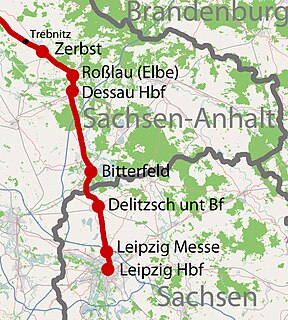
The Trebnitz–Leipzig railway is a double track electrified main line in the German states of Saxony-Anhalt and Saxony built and originally operated by the Berlin-Anhalt Railway Company. It formally starts at Trebnitz on the former border between the Duchy of Anhalt and Prussia and runs via Dessau and Delitzsch to Leipzig. The section from Bitterfeld to Leipzig is part of Line 1 of the Trans-European Transport Networks (TEN-T). Until 1871, the Zerbst–Roßlau section was called the Anhaltische Leopoldsbahn.
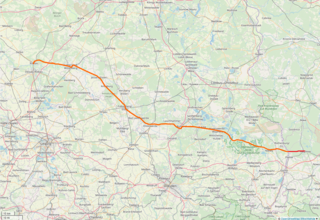
The Węgliniec–Roßlau (Elbe) railway is a mainline railway in Poland and the German states of Saxony, Brandenburg and Saxony-Anhalt, originally built by the Berlin-Anhalt Railway Company and the Upper Lusatian Railway Company as part of the trunk line from Breslau to Magdeburg. It runs from Węgliniec via Niesky, Hoyerswerda, Falkenberg (Elster) and Wittenberg to Roßlau (Elbe). The line is sometimes called the Niederschlesische Gütermagistrale because it provides a direct connection from the province of Lower Silesia to Central Germany. The western section of the line is one of the oldest lines in Germany.
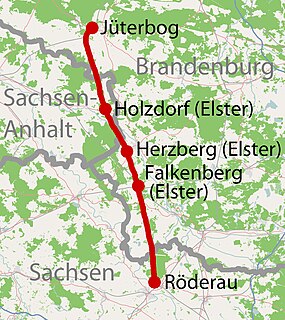
The Jüterbog–Röderau railway is an electrified main line in the German states of Brandenburg, Saxony-Anhalt and Saxony. It runs from Jüterbog via Falkenberg (Elster) to Röderau, near Riesa. There it ends in a triangular junction with the Leipzig–Dresden railway, connecting to Riesa and Dresden. The Jüterbog–Falkenberg section consists of a single track; the Falkenberg–Riesa section has two tracks. It was opened in 1848 and is one of the oldest lines in Germany.

Doberlug-Kirchhain is a bi-level railway station in the town of Doberlug-Kirchhain, Brandenburg, Germany. The station lies of the Berlin–Dresden railway and Halle–Cottbus railway and the train services are operated by Deutsche Bahn.

The Großenhain–Cottbus railway is an electrified main railway in the German states of Saxony and Brandenburg. It is double track between Cottbus and Ruhland and elsewhere single-track. It runs from Großenhain via Ruhland and Senftenberg to Cottbus.

Lutherstadt Wittenberg Hauptbahnhof is a railway station located in Wittenberg, Germany. The station opened on 3 August 1859 is located on the Berlin–Halle railway and Roßlau–Falkenberg/Elster railway. The train services are operated by Deutsche Bahn. With over 5000 passengers per day, it is the most important railway station in the eastern part of the state of Saxony-Anhalt.
The Halle–Cottbus railway is a 176 km long double-track electrified main line in the German states of Saxony-Anhalt, Saxony and Brandenburg. It was opened in 1871 and 1872. It formed the central section of the network of the Halle-Sorau-Guben Railway Company. Today it is part of a connection between the Central Germany and Poland.
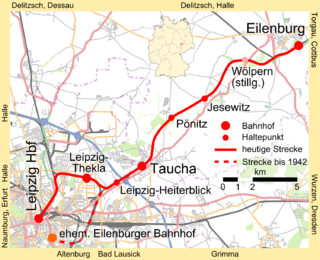
The Leipzig–Eilenburg railway is a two-track, electrified mainline railway in the German state of Saxony, originally built and operated by the Halle-Sorau-Guben Railway Company as the Eilenburg Railway. It runs from Leipzig to Eilenburg and is part of the long-distance connection from Leipzig to Cottbus.

Eilenburg station is one of two railway stations in the district town of Eilenburg in the German state of Saxony. It is classified by Deutsche Bahn as a category 4 station. The station is located on the southeastern edge of the town.
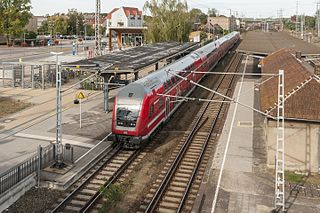
Falkenberg (Elster) station is one of the biggest stations in the German state of Brandenburg. It is located in the town of Falkenberg/Elster in the south of the state. It is classified by Deutsche Bahn as a category 3 station. Railways run in seven directions from the station. It is a two-level interchange station, built where several routes interconnect. There is a large marshalling yard connecting to both the upper and the lower parts of the station. At times Falkenberg was the fifth largest marshalling yard in East Germany (GDR). Only part of these tracks have been in use since the 1990s.

Ruhland station is located in the town of Ruhland in northwestern Upper Lusatia in the south of the German state of Brandenburg on the Großenhain–Cottbus railway and the Węgliniec–Roßlau railway. The station is a heritage-listed building.

Hosena station is a station at the junction of the Węgliniec–Roßlau railway and the Lübbenau–Kamenz railway. The station is located in the southeast of the German state of Brandenburg in the village of Hosena, north of the village of Hohenbocka.

The Upper Lusatian Railway Company, which had its headquarters in Ruhland now in the Oberspreewald-Lausitz district, received a concession on 11 October 1871 for the construction of a railway line, partly to provide a direct connection from Breslau to Magdeburg. The 148 km long-route lead west from the rail node of Kohlfurt through Upper Lusatia via Horka, Hoyerswerda, Ruhland and Elsterwerda-Biehla to Falkenberg in the Lower Lusatia.

The Cottbus–Frankfurt (Oder) railway is a single-track main line in the German state of Brandenburg, which was originally built and operated by the Cottbus-Großenhain Railway Company and directly connects the two cities to each other. It runs from Cottbus via Peitz to Frankfurt (Oder). Only the section between Grunow and Frankfurt and a short section near Cottbus are still in operation. Trains running over the line now use the line to Guben and continue on the line of the former Lower Silesian-Mark Railway .
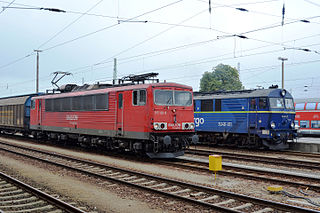
The Cottbus–Guben railway is a two-track electrified main line in the Southeast of the German state of Brandenburg. It connects the city of Cottbus with the town of Guben, which is on the German–Polish border and the Lusatian Neisse. The line is served every hour by Regional-Express service RE 11, which connects Cottbus, Guben and continues towards Eisenhüttenstadt and Frankfurt (Oder). Starting in 2002, parts of the line were rerouted in the Cottbus area to allow the expansion of the Cottbus-Nord lignite mine.

Guben station is a station of Guben in the German state of Brandenburg. It is at the junction of lines from Berlin to Wrocław via Frankfurt (Oder) and from Cottbus to Zbąszynek. The station building is surrounded by the tracks. Only the route between Frankfurt (Oder)–Cottbus is used by passenger services, while the line towards Zbąszynek is used for freight traffic.

The Großenhain–Priestewitz railway is a single-track electrified main line in the German state of Saxony, which was originally built by the Großenhain Branch Railway Company. It runs from Großenhain to Priestewitz and is part of the long-distance line from Cottbus to Dresden. The railway is also called the Celery Railway (Selleriebahn).

Delitzsch oberer Bahnhof is an intermediate station on the double-tracked and electrified Halle–Cottbus railway and one of the two passenger station serving the town of Delitzsch in the Nordsachsen district of Germany. It is currently only a halt with two side platforms.
"Halle-Sorau-Gubener Eisenbahn" (in German). Bahnstrecken in Brandenburg. Retrieved 19 August 2014.